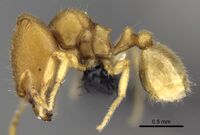Carebara jajoby
| Carebara jajoby | |
|---|---|

| |
| Scientific classification | |
| Kingdom: | Animalia |
| Phylum: | Arthropoda |
| Class: | Insecta |
| Order: | Hymenoptera |
| Family: | Formicidae |
| Subfamily: | Myrmicinae |
| Tribe: | Crematogastrini |
| Genus: | Carebara |
| Species: | C. jajoby |
| Binomial name | |
| Carebara jajoby Azorsa & Fisher, 2018 | |
Carebara jajoby specimens have been collected from forest litter samples and found in the following microhabitats: dead twigs above ground, rotten logs, rotten logs in root mat, ground nests, sifted litter, leaf mold, rotten wood, under rootmat, litter on rocks, and under stones.
Identification
Azorsa and Fisher (2018) - Antennae ten or eleven-segmented (only larger major workers, minor workers always with ten segments). Major: Head longer than wide, slightly narrowed anteriorly and on the top, posterior margin of head deeply concave, posterolateral corners well developed and narrowed posteriorly; posterodorsal corner of propodeum with a pair of triangular teeth, dorsum flat and declining posteriorly; petiolar node thin, anterodorsal and posterodorsal corner rounded, dorsum weakly convex, combined outline of dorsal surface of peduncle and anterior face of node concave to nearly straight, posterior face vertical and nearly straight. Minor: Head slightly longer than wide; posterodorsal corner of propodeum with a pair of triangular teeth, dorsum flat and declining posteriorly; petiolar node thin with the top bluntly prominent, combined outline of dorsal surface of peduncle and anterior face of node weakly concave, posterior face vertical and almost straight; gaster with abundant subdecumbent hairs.
There are four intermediates in the major worker subcaste. The posterolateral corners of head of intermediates narrow posteriorly and increase in size from intermediate 1 to 4. The posterior margin of the head in intermediates 1 and 2 is less concave than intermediates 3 and 4. The lateral margins of the head are convex in all intermediates, with intermediate 4 having lateral margins nearly straight. The eyes are small and reduced to one ommatidium in intermediates 1, 2 and 3, while between 2 and 30 ommatidia are found in intermediate 4. Ocelli are absent in intermediates 1, 2 and 3, but one ocellus is present and well developed in intermediate 4. Reduced flight sclerites are present in intermediate 4. The dorsum of the mesosoma is convex anteriorly and gradually slopes to the declivity in intermediate 4. The dorsum of the promesonotum is high and nearly rounded in intermediates 1, 2 and 3. The shape of the petiole and postpetiole do not vary much in intermediates, with the exception of intermediate 4, where the combined outline of dorsal surface of peduncle and anterior face of node is nearly straight. The propodeum is armed with a pair of triangular teeth in all intermediates. The head is smooth and shiny in the frontal area and with finely longitudinal and parallel rugae in full-face view in all intermediates. Pilosity on head and body follows the same pattern in all intermediates, except for intermediate 4, which has abundant and very short appressed hairs on the gaster. Larger major workers with eleven antennal segments, and seven teeth.
Carebara jajoby is similar to Carebara sampi, Carebara vazimba, and Carebara kabosy, but can be separated from them by the following combination of characters. In major workers, dorsum of head of C. sampi is smooth and shiny or with fine longitudinal rugae laterally. In case the dorsum of head presents well-defined longitudinal rugae like C. vazimba, C. kabosy, and C. jajoby then the propodeal tooth of C. jajoby is longer than the diameter of the propodeal spiracle. In minor workers, C. jajoby can be separated from the others species by the prescence of abundant subdecumbent hairs in the gaster, and with fewer than ten longer suberect hairs. C. jajoby is distributed from the east and northwest of Madagascar, while C. sampi is distributed from south and southwestern, C. vazimba is distributed in the north, northeastern and northwestern. Nine other species were recorded at the same localities: Carebara bara, Carebara betsi, Carebara grandidieri, Carebara hainteny, Carebara hiragasy, C. kabosy, Carebara mahafaly, Carebara nosindambo, and Carebara placida.
Keys including this Species
Distribution
Azorsa and Fisher (2018) - known from the east and northwest of Madagascar. This species was mainly found in littoral rainforest, montane rainforest, montane shrubland, rainforest, and rainforest (transition to montane forest). C. jajoby is distributed in elevations ranging from 10 m to 2000 m.
Latitudinal Distribution Pattern
Latitudinal Range: -13.58487° to -25.06167°.
| North Temperate |
North Subtropical |
Tropical | South Subtropical |
South Temperate |
- Source: AntMaps
Distribution based on Regional Taxon Lists
Malagasy Region: Madagascar (type locality).
Distribution based on AntMaps
Distribution based on AntWeb specimens
Check data from AntWeb
Countries Occupied
| Number of countries occupied by this species based on AntWiki Regional Taxon Lists. In general, fewer countries occupied indicates a narrower range, while more countries indicates a more widespread species. |

|
Estimated Abundance
| Relative abundance based on number of AntMaps records per species (this species within the purple bar). Fewer records (to the left) indicates a less abundant/encountered species while more records (to the right) indicates more abundant/encountered species. |

|
Biology
Castes
Worker
Images from AntWeb
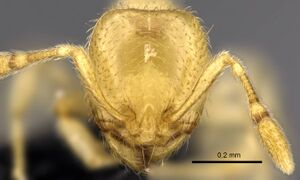 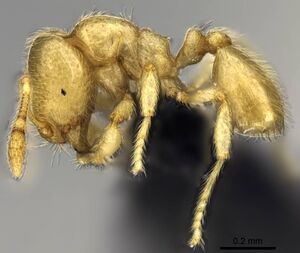 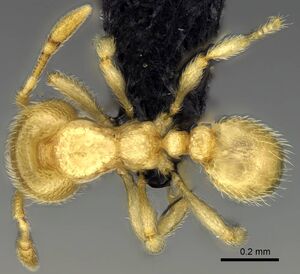 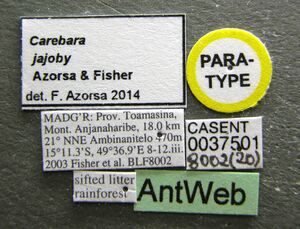
| |
| Paratype of Carebara jajoby. Worker. Specimen code casent0037501. Photographer Frank Azorsa, uploaded by California Academy of Sciences. | Owned by CAS, San Francisco, CA, USA. |
Queen
Images from AntWeb
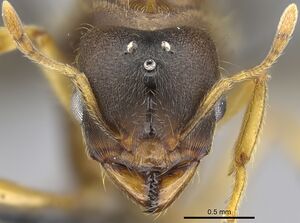 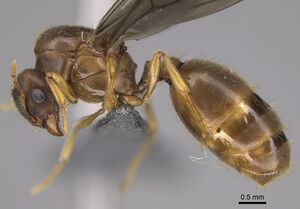 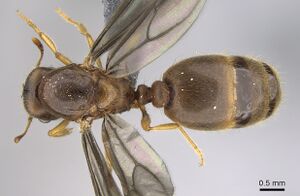  
| |
| Queen (alate/dealate). Specimen code casent0300690. Photographer Frank Azorsa, uploaded by California Academy of Sciences. | Owned by CAS, San Francisco, CA, USA. |
Male
Images from AntWeb
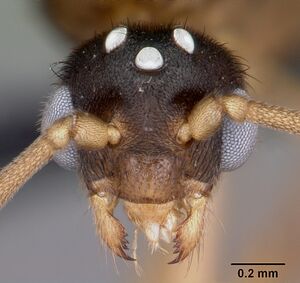  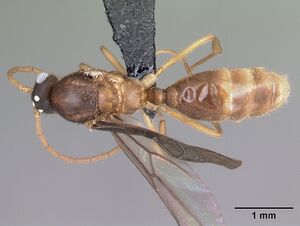 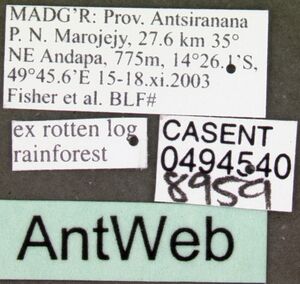
| |
| Male (alate). Specimen code casent0494540. Photographer April Nobile, uploaded by California Academy of Sciences. | Owned by CAS, San Francisco, CA, USA. |
Nomenclature
The following information is derived from Barry Bolton's Online Catalogue of the Ants of the World.
- jajoby. Carebara jajoby Azorsa & Fisher, 2018: 74, figs. 43, 44, 68 (s.w.) MADAGASCAR.
- Type-material: holotype major worker, 54 paratype major workers, 23 paratype minor workers.
- Type-locality: holotype Madagascar: Toamasina, Montagne d’Anjanaharibe, 18.0 km. 21° NNE Ambinanitelo, -15.18833, 49.615, 470 m., 8-12.iii.2003, BLF08002, rainforest (B.L. Fisher, C.E. Griswold, et al.); paratypes: 45 major workers, 23 minor workers with same data, 9 major workers with same data but BLF08025, BLF08054, BLF08070, BLF08110, and BLF08128.
- Type-depositories: CASC (holotype); BMNH, CASC, MCZC, MHNG, NHMB (paratypes).
- Distribution: Madagascar.
Unless otherwise noted the text for the remainder of this section is reported from the publication that includes the original description.
Description
Worker
Major. n=27): HL 0.62–1.18 (0.97); HW 0.51–0.92 (0.75); SL 0.27–0.45 (0.38); ML 0.14–0.31 (0.26); EL 0.01–0.14 (0.04); EM 0.16–0.30 (0.27); HD 0.33–0.70 (0.55); WL 0.53–1.12 (0.80); PSL 0.06–0.18 (0.15); PW 0.31–0.60 (0.48); MFL 0.32–0.63 (0.47); MFW 0.07–0.15 (0.11); MTL 0.26–0.51 (0.39); PTL 0.21–0.43 (0.36); PNL 0.08–0.15 (0.12); PTH 0.16–0.27 (0.24); PTW 0.14–0.27 (0.23); PPL 0.12–0.22 (0.18); PPNL 0.11–0.21 (0.15); PPH 0.12–0.26 (0.20); PPW 0.18–0.33 (0.27); GL 0.40–1.54 (0.66); GW 0.37–0.92 (0.66); CI 72–87 (77); MI 22–29 (27); SI 34–45 (39); MLI 58–70 (63); PPLI 45–62 (50); PPI 116–134 (117); PSI 11–26 (20).
Head longer than wide (CI 72–87), in full-face view roughly subrectangular, about 1.3 times longer than wide, narrowed anteriorly and on the top. Posterior margin of head deeply concave, V-shaped, posterolateral corners well developed and narrowed posteriorly, lateral margins moderately convex. Mandibles with six or seven teeth. Anterior margin of clypeus straight to slightly concave, and laterally angulate. Antennae with ten or eleven segments. Scapes short (HL 0.62–1.18, SL 0.27–0.45, SI 34–45). Ocelli absent or present. Eyes present, consisting of one to 50 ommatidia (EL 0.01–0.14). Supraclypeal area mostly triangular, apex varies from acute on small and medium major workers, to rounded on larger major workers.
In profile view, posterolateral corner of head with a small, obtuse tooth resembling a horn. Promesonotum high and nearly rounded, metanotal groove deeply impressed. Propodeum lower than promesonotum. Propodeum about 1.75 times higher than long, dorsal face of propodeum nearly flat, to weakly concave, declining posteriorly; posterodorsal corners of propodeum each armed with a triangular tooth; anterodorsal corner convex, declivity vertical and concave with narrow lateral laminae. Propodeal lobes short and convex. Propodeal spiracle rounded and situated above mid-height of sclerite, and beyond mid-length of sclerite by about half the diameter of the spiracle, distance from propodeal spiracle to posterodorsal corner of propodeum about four times the diameter of the spiracle (PSL 0.06–0.18), and distance to declivity almost twice the diameter of the spiracle. In dorsal view, promesonotum about as long as wide, anterior margin and sides of promesonotum rounded; sides of propodeum straight.
Petiole longer than high (PTL 0.21–0.43, PTH 0.16–0.27) and with relatively long peduncle, ventral face weakly convex in the middle. Combined outline of dorsal surface of peduncle and anterior face of node concave or nearly straight, posterior face of node vertical, anterodorsal corner convex, posterodorsal corner rounded, dorsum convex. Subpetiolar process produced as a very small denticle, same as or slightly shorter than the diameter of the propodeal spiracle. Postpetiolar node rounded and lower than petiolar node. In dorsal view, petiolar node not as broad as postpetiolar node (PPW 0.18–0.33, PTW 0.14–0.27) and petiolar node wider than long (PTW 0.14– 0.27, PNL 0.08–0.15), anterior margins of petiole and postpetiole nearly straight, sides of petiole rounded, convex in postpetiole, narrowed posteriorly.
Dorsal surface of mandibles, clypeus, supraclypeal area and frons smooth and shiny, with scattered piligerous punctae on head and mandibles. Head with longitudinal rugae directed to posterior margin, gena with well-developed longitudinal rugae directed to posterolateral corners of head. In profile, posterolateral portion of cephalic dorsum smooth and shiny, larger specimens with weakly marked longitudinal rugae. Sides of pronotum with transverse and longitudinal fine rugae, median area unsculptured on smaller major workers; katepisternum areolate, metapleuron finely areolate. Petiole and ventral face of postpetiole areolate. In dorsal view, mesosoma, petiole, postpetiole and gaster smooth and shiny; propodeum weakly sculptured.
Lateral margins with long suberect hairs and short appressed hairs. Scapes with appressed hairs. Outer margin of mandible with short and sparse appressed hairs. Mesosoma with short decumbent to appressed hairs, and long suberect or subdecumbent hairs. Petiole and postpetiole with short decumbent or appressed hairs and long subdecumbent hairs. Tibia with appressed hairs. Gaster with short decumbent hairs and long subdecumbent hairs. Color yellowish ferruginous.
Minor. (n=11): HL 0.37–0.45; HW 0.34–0.40; SL 0.24–0.28; ML 0.09–0.12; EL 0.01–0.02; EM 0.11–0.14; HD 0.21–0.28; WL 0.39–0.47; PSL 0.03–0.07; PW 0.21–0.25; MFL 0.25–0.31; MFW 0.06–0.08; MTL 0.18–0.25, PTL 0.15–0.19; PNL0.06–0.09; PTH 0.11–0.13; PTW 0.09–0.11; PPL 0.09–0.10; PPNL 0.08–0.10; PPH 0.09–0.10; PPW 0.12–0.15; GL 0.28–0.40; GW 0.26–0.34; CI 84–93; MI 22–28; SI 60–65, MLI 72–82; PPLI 50– 67; PPI 127–156; PSI 9–18.
Head longer than wide (CI 84–93), in full-face view nearly subquadrate, about 1.1 times longer than wide, weakly narrowed anteriorly. Posterior margin of head slightly concave, posterolateral corners rounded, lateral margins convex. Mandibles with six teeth. Anterior margin of clypeus nearly straight, and laterally angulate. Antennae with ten segments. Scape fails to reach the posterior margin of head (HL 0.37–0.45, SL 0.24–0.28, SI 60–65). Eyes present, consisting of one ommatidium (EL 0.01–0.02). Supraclypeal area almost triangular but poorly defined.
In profile view, promesonotum weakly convex, nearly flat, metanotal groove deeply impressed. Propodeum about 1.58 times higher than long, dorsal face of propodeum flat, declining posteriorly, anterodorsal corner rounded, posterodorsal corners each armed with a triangular tooth, declivity vertical and nearly flat, with thin lateral laminae. Propodeal lobes short and convex. Propodeal spiracle nearly oval and situated above mid-height of sclerite by about half the diameter of the spiracle, and beyond mid-length of sclerite by about 1.5 times the diameter of the spiracle, distance from propodeal spiracle to posterodorsal corner of propodeum about 2.5 times the diameter of the spiracle (PSL 0.03–0.07), and distance to declivity same as the diameter of the spiracle. In dorsal view, promesonotum about 1.16 times longer than wide, anterior margin rounded, sides convex and narrowed posteriorly; sides of propodeum weakly convex.
Petiole longer than high (PTL 0.15–0.19, PTH 0.11–0.13) and with relatively short peduncle, ventral face medially convex. Combined outline of dorsal surface of peduncle and anterior face of node weakly concave, posterior face of node vertical and slightly concave, anterodorsal and posterodorsal corners rounded, dorsum convex. Subpetiolar process weakly present as denticle, shorter than the diameter of the propodeal spiracle. Postpetiolar node nearly rounded and lower than petiolar node. In dorsal view, postpetiolar node wider than petiolar node (PPW 0.12–0.15, PTW 0.09–0.11), petiolar node wider than long (PTW 0.09–0.11, PNL 0.06–0.09), anterior and posterior margins of petiole and postpetiole nearly straight, lateral margins rounded in petiole and postpetiole.
Dorsal surface of head, mandibles, clypeus and supraclypeal area smooth and shiny, with scattered piligerous punctae on head and mandibles. Gena and frontal lobes with longitudinal rugae. Mesosoma smooth and shiny, except for katepisternum (mesopleuron) and metapleuron (finely areolate-rugose). Petiole and ventral margin of postpetiole areolate. In dorsal view, promesonotum, postpetiole and gaster smooth and shiny; propodeum and petiole finely areolate.
Lateral margins and posterior margin of head with short decumbent hairs, and long suberect hairs. Scapes with abundant decumbent hairs. Outer margin of mandible with decumbent hairs. Mesosoma with short decumbent hairs and long suberect or subdecumbent hairs. Petiole and postpetiole with short decumbent hairs and longer subdecumbent hairs. Tibia with appressed hairs. Gaster with abundant decumbent hairs and long subdecumbent hairs. Color yellowish ferruginous.
Type Material
Holotype. (major worker), Madagascar, Toamasina, Montagne d’Anjanaharibe, 18.0 km 21° NNE Ambinanitelo, -15.18833, 49.615, 470 m, rainforest, 8–12.iii.2003, (Fisher, Griswold et al.). Collection code BLF08002, (California Academy of Sciences: CASENT0037505). Paratypes: (45 major workers and 23 minor workers), with same data as holotype, 26 major workers (The Natural History Museum: CASENT0037498, CASC: CASENT0037566, CASENT0037542, CASENT0037486, CASENT0037496, CASENT0037522, CASENT0037538, CASENT0037532, CASENT0037536, CASENT0037540, CASENT0037555, CASENT0037495, CASENT0037476, CASENT0037518, CASENT0037544, CASENT0037547, CASENT0037554, CASENT0037483, CASENT0037560, CASENT0037558, CASENT0037551, CASENT0037550, CASENT0037562, Museum of Comparative Zoology: CASENT0037533, Musee d'Histoire Naturelle Genève: CASENT0037524, Naturhistorisches Museum, Basel: CASENT0037521), and 23 minor workers (BMNH: CASENT0037467, CASC: CASENT0037549, CASENT0037479, CASENT0037568, CASENT0037563, CASENT0037552, CASENT0037484, CASENT0037503, CASENT0037525, CASENT0037501, CASENT0037565, CASENT0037535, CASENT0037556, CASENT0037543, CASENT0037534, CASENT0037528, CASENT0037515, CASENT0037557, CASENT0037553, CASENT0037497, MCZ: CASENT0037499, MHNG: CASENT0037512, NHMB: CASENT0037559). With same data as holotype but with different collection codes, 4 major workers, BLF08054, (CASC: CASENT0495342, CASENT0495343), BLF08128, (CASC: CASENT0495466, CASENT0495467). 1 major worker, BLF08110, (CASC: CASENT0495483), 2 major workers, BLF08025, (CASC: CASENT0495307, CASENT0495306), and 2 major workers, BLF08070, (CASC: CASENT0495243, CASENT0495244).
